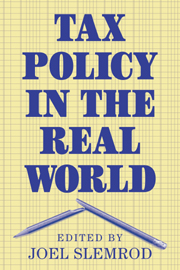Book contents
- Frontmatter
- Contents
- List of contributors
- 1 The real world of tax policy
- 2 Federal tax reform
- 3 Federalism and subfederal taxes
- 4 Principles, politics, and the professors
- Public finance in theory and practice
- On the use of ‘distribution tables’ in the tax policy process
- Taxation and economic growth
- Tax reform of the century – the Swedish experiment
- Measuring the impact of tax reform
- What is an ‘optimal’ tax system?
- How tax complexity and enforcement affect the equity and efficiency of the income tax
- Tax policy from a public choice perspective
- What is missed if we leave out collective choice in the analysis of taxation
- Public finance and public choice
- Professional opinions about tax policy: 1994 and 1934
- What can America learn from the British tax system?
- Peculiar institutions: a British perspective on tax policy in the United States
- Index
Taxation and economic growth
Published online by Cambridge University Press: 01 June 2010
- Frontmatter
- Contents
- List of contributors
- 1 The real world of tax policy
- 2 Federal tax reform
- 3 Federalism and subfederal taxes
- 4 Principles, politics, and the professors
- Public finance in theory and practice
- On the use of ‘distribution tables’ in the tax policy process
- Taxation and economic growth
- Tax reform of the century – the Swedish experiment
- Measuring the impact of tax reform
- What is an ‘optimal’ tax system?
- How tax complexity and enforcement affect the equity and efficiency of the income tax
- Tax policy from a public choice perspective
- What is missed if we leave out collective choice in the analysis of taxation
- Public finance and public choice
- Professional opinions about tax policy: 1994 and 1934
- What can America learn from the British tax system?
- Peculiar institutions: a British perspective on tax policy in the United States
- Index
Summary
Abstract - Tax reforms are sometimes touted as having strong macroeconomic growth effects. Using three approaches, we consider the impact of a major tax reform—a 5 percentage point cut in marginal tax rates—on long-term growth rates. The first approach is to examine the historical record of the U.S. economy to evaluate whether tax cuts have been associated with economic growth. The second is to consider the evidence on taxation and growth for a large sample of countries. And finally, we use evidence from microlevel studies of labor supply, investment demand, and productivity growth. Our results suggest modest effects, on the order of 0.2 to 0.3 percentage point differences in growth rates in response to a major tax reform. Nevertheless, even such small effects can have a large cumulative impact on living standards.
INTRODUCTION
By now, a presidential campaign is incomplete without at least one proposal for tax reform. Recent proposals suggested that by reducing marginal tax rates, or by replacing the current federal income tax with a consumptiontype tax, the United States can experience increased work effort, saving, and investment, resulting in faster economic growth. For example, Steve Forbes vaulted briefly into the political limelight based almost solely on his advocacy of a flat tax which cut nearly every person's tax bill, but which was supposed to balance the budget by stimulating economic growth.
- Type
- Chapter
- Information
- Tax Policy in the Real World , pp. 305 - 330Publisher: Cambridge University PressPrint publication year: 1999
- 6
- Cited by

